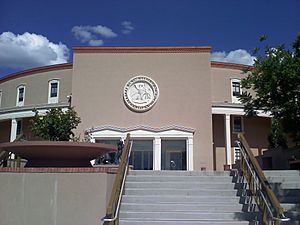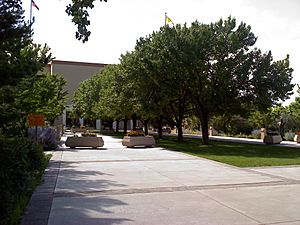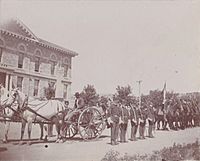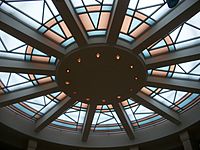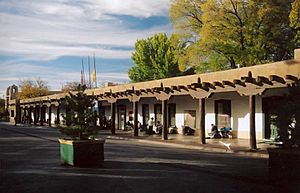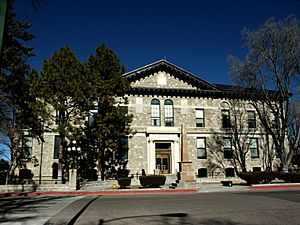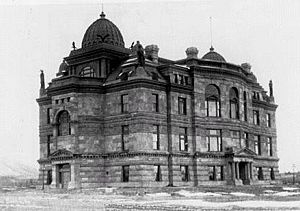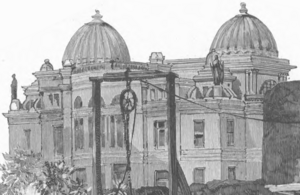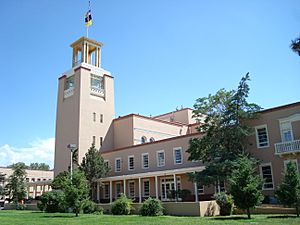New Mexico State Capitol facts for kids
The New Mexico State Capitol is a special building in Santa Fe. It is the main government building for the New Mexico state. You can find it at 490 Old Santa Fe Trail. This capitol building is unique because it is the only round state capitol in the entire United States. Because of its shape, many people call it "the Roundhouse".
Contents
What Does the New Mexico Capitol Look Like?
The New Mexico State Capitol was designed to look like the Zia sun symbol when you see it from above. It has a round main part with four wings sticking out. These wings are the entrances. The building mixes New Mexico's traditional Territorial Revival style with classic Neoclassical architecture.
Above each entrance, you can see a stone carving of the official State Seal of New Mexico. The building has four levels, and one of them is underground.
The capitol building was officially opened on December 8, 1966. It was designed by W.C. Kruger. The building is very large, covering about 232,346 square feet (22,000 m2).
Inside the Roundhouse: Chambers and Offices
The capitol is where the New Mexico State Legislature meets. This is the group of people who make laws for the state.
The first floor is underground. It holds the semicircular rooms for the House and Senate. These rooms are where lawmakers meet. The public cannot go into these specific rooms.
The second floor is the ground floor. Here, visitors can go to special galleries to watch the House and Senate meetings. The House gallery can seat 281 people. It is on the south side of the building. The Senate gallery is on the north side and can seat 206 people.
The two top floors are mostly for offices. Legislative committee offices are on the third floor. The offices for the Governor, Lieutenant Governor, and other legislative services are on the fourth floor.
The Beautiful Rotunda
In the middle of the building is the Rotunda. This is a large, round open space. It is about 49 feet (15 m) wide and 60 feet (18 m) tall. It goes up through the second, third, and fourth floors.
The Rotunda is decorated with a special type of marble called Travertine, which comes from New Mexico. On the floor, there is a beautiful mosaic made of turquoise and brass. It shows the Great Seal of New Mexico. The ceiling has a skylight that looks like an Indian basket weave. It has blue and pale pink stained glass that represents the sky and the earth.
On the fourth-floor balcony, you can see the flags of all 33 counties in New Mexico. They are always on display there.
Capitol Gardens and Art
Around the capitol building, there is a large garden that covers about 6.5 acres (2.6 hectares). It has over 100 different kinds of plants. You can find roses, plum trees, almond trees, and even giant sequoias. There are also statues of native Pueblo people carrying pottery and hunting.
In 1992, the building was updated. This included making it easier for people with disabilities to get around. The building was rededicated on December 4, 1992.
Capitol Art Foundation: Art for Everyone
The Legislature started the Capitol Art Foundation in 1991. This foundation helps to get art for the capitol building. The art is shown in public areas on all four floors. It includes many different types of art, like paintings, sculptures, and even handcrafted furniture.
The goal of the Foundation is to collect and show art that represents the history, cultures, and art forms of the people of New Mexico.
Governor's Gallery: A Place for Art Shows
The Governor's Gallery is on the fourth floor of the New Mexico State Capitol. It was created in 1975 to teach people about the state's artistic history. The very first art show there featured paintings by the famous artist Georgia O'Keeffe.
The gallery changes its art shows several times a year. Every fall, it holds a special exhibition for the annual Governor's Awards for Excellence in the Arts.
History of New Mexico's Capitol Buildings
The Roundhouse is actually the fourth capitol building New Mexico has had. New Mexico has one of the newest capitol buildings in the U.S. (only Hawaii and Florida have newer ones). But it also has the oldest capitol building in the U.S., the Palace of the Governors!
The Palace of the Governors: The Oldest Capitol
The Palace of the Governors was built in 1610 by the Spanish. It is located on the Santa Fe Plaza. For almost 300 years, it was the main government building in Santa Fe. This was during the times when Spain and Mexico ruled New Mexico.
When the United States took over New Mexico in 1846, the Palace became the first territorial capitol. It was used for 40 years. Today, the Palace is a museum. It is the only capitol building in the U.S. that has been home to the governments of three different nations!
The 1850 Capitol: A Building That Waited
Work on a new capitol building started in 1850. This was because New Mexico was hoping to become a state soon. However, the money for building it ran out quickly. In 1855, work stopped with only the first floor finished.
The building stayed unfinished until 1886. That's when the second floor and roof were finally added. But by then, a brand new territorial capitol was already being built. So, this 1850 building was never officially used as the capitol. It did temporarily house the government between 1892 and 1900. Instead, it became the Territorial (and later Federal) Courthouse. This building still stands today, looking much as it did then.
The 1886 Capitol: Lost to Fire
In 1886, a new building took the place of the old Palace of the Governors as the territorial capitol. This grand building was four stories tall. It was made from sandstone from Lamy. On top, it had huge bronze statues representing Liberty, Justice, Commerce, and Industry. Chicago architect E. S. Jennison designed it.
Just six years after it opened, on the evening of May 12, 1892, a fire started. The fire completely destroyed the building. Luckily, people nearby were able to save most of the important papers, books, and furniture. The building was not insured, so its loss cost the state over $200,000.
An investigation found that the fire was likely set on purpose. It reportedly started in two different places at the same time. Also, a very important emergency hose seemed to have been tampered with. The person who did it and why they did it were never found out.
The 1900 Capitol: A New Beginning
The next capitol building was designed by Isaac Rapp. It was not finished until 1900. While it was being built, the government worked out of the Territorial Court House.
After the expensive fire, this new capitol was built on a very tight budget. It cost less than $140,000. Workers used materials saved from the old capitol. They also used unpaid labor from prisoners at the Penitentiary of New Mexico to save money.
This building was three stories tall. It had a silver dome, a small tower called a cupola, and a classic neoclassical entrance with columns. The first floor was made from sandstone reused from the old capitol. The second and third floors were yellow brick. The entrance was made of Indiana limestone. It was officially opened on June 4, 1900.
It was in this building, on January 6, 1912, that President William Howard Taft signed the paper that made New Mexico the 47th state of the Union. He then told the New Mexico group, "Well, it is all over. I am glad to give you life. I hope you will be healthy."
Over the next few decades, more buildings were added next to the capitol. In 1950, a big project began to make all the government buildings look the same. They were changed to the Territorial Revival style. The dome, which some people thought didn't fit the state, was removed. A 105-foot (32 m) tower was added to the north end of the building.
This building is now called the Bataan Memorial Building. It honors the soldiers who suffered in the Bataan Death March. It now holds many state government offices. The original 1900 capitol building is mostly hidden by these newer additions. However, its arched windows on the third story can still be seen.
See also
 In Spanish: Capitolio del Estado de Nuevo México para niños
In Spanish: Capitolio del Estado de Nuevo México para niños


